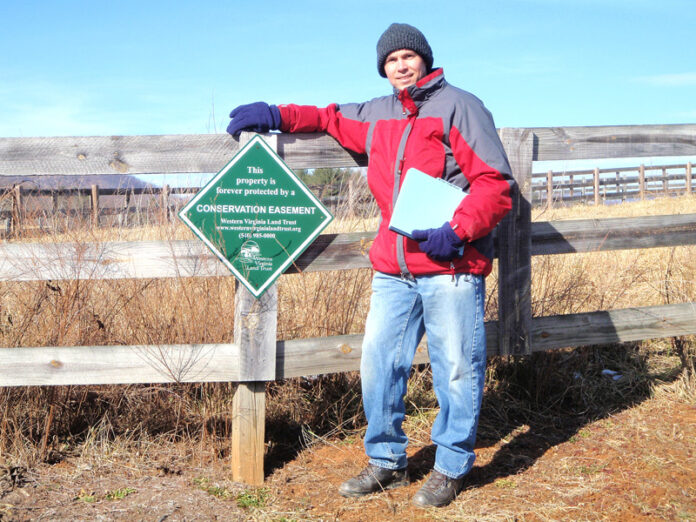
by Gene Marrano
The new executive director for the Western Virginia Land Trust, replacing the recently retired Roger Holnback, is a familiar face: David Perry, who has worked for the WVLT since 2006 and was most recently the assistant director. After two weeks in an interim role, Perry, a Blacksburg native and James Madison University graduate, was elevated to formally succeed Holnback by the Land Trust board of directors.
The Western Virginia Land Trust works with landowners who want to preserve their property in perpetuity from over-development, by seeking a conservation easement that affords property tax relief. In return for the tax break, landowners – usually rural property holders of farmland or mountain tracts – place restrictions that prohibit or severely limit any development.
Perry (40) also earned a master’s in natural resources from Slippery Rock (PA), a division II school that always has its football scores announced at halftime of games at the University of Michigan, a division one football powerhouse. “That’s how most people know Slippery Rock,” chuckles Perry, who studied geography in school.
He started as a project manager for the Western Virginia Land Trust, which involved everything from meeting with landowners to creating newsletters. Much of the non-profit’s work involves educating the public; the WVLT holds about 40 conservation easements but in many cases the actual legal document is held by a state agency, the Virginia Outdoors Foundation. All told there are about 350 easements in the region, said Perry.
Being named the permanent executive director was “humbling and honoring,” said Perry. “Roger had been there ten years and we had accomplished an awful lot.” Established in 1996 as an offshoot of the Clean Valley movement, former Roanoke City Councilman Rupert Cutler was the first executive director. “Now [there are] about 86,000 acres that we’ve had a role in [preserving], directly or indirectly,” said Perry.
Former Governor Tim Kaine pledged to preserve 400,000 acres of open space statewide during his administration and by some measurements attained that goal; Perry said current governor Bob McDonnell pledged the same but has been hampered by a poor economy. “The state’s not had the money to make the purchases,” said Perry, noting that the McDonnell administration is relying more on the donation of land for now.
Acquiring open space is different than a conservation easement, where the original landowner holds on to the property, but the result is the same: saving unspoiled land from development. In some northern Virginia counties where over-development has long been a concern, as much as 25 percent of the acreage is protected by conservation easements. “That’s considerable,” said Perry. In the Roanoke area it’s more like 3 to 5 percent of acreage that has been preserved.
Landowners under conservation easements often agree to items like no or limited building on their property, good timbering practices, not allowing billboards, etc., “things that the people doing the easement probably wouldn’t do anyway,” said Perry. The land can be passed on to children or even sold, but the new owners must abide by the easement in place.
The WVLT works in a six county area surrounding the Roanoke Valley. “Hopefully it will never become that urban sprawl mess that we see in the other parts of the state,” noted Perry. Virginia is actually one of the top states nationally when it comes to land preservation and number one in the southeast, he adds.
Holnback, a former yacht captain for a wealthy British citizen who often cruised the Mediterranean, had “an incredible passion for this place,” said Perry. Holnback saw paradises marred by over development and commercialism elsewhere. “He came to the Roanoke Valley… and saw a place that hadn’t been spoiled.” That led Holnback to seek the WVLT position.
No one can force an easement on a property owner. Perry spends much of his time educating people about the ins and outs of the agreements when he meets with interested parties or groups. “We want everybody that has a conservation easement to be happy with it. We take our time and make sure it’s right for them.” The WVLT has helped preserve much of Mill Mountain in the past.
The organization is largely funded by private donations, although local governments do allot small sums of money. Events like the 5K Race for Open Space (Green Hill Park, June 2) help fund the WVLT, as does a photography competition held at the O. Winston Link (just before Christmas this year.)
Perry (also a freelance writer who has contributed to the Star-Sentinel) wants to assure those who are more prone to see construction opportunities when they see open tracts of land: “we’re not anti-development, we [just] want to see development that is in character and appropriate for the landscape.” Now it’s his job to offer those assurances as the executive director.

